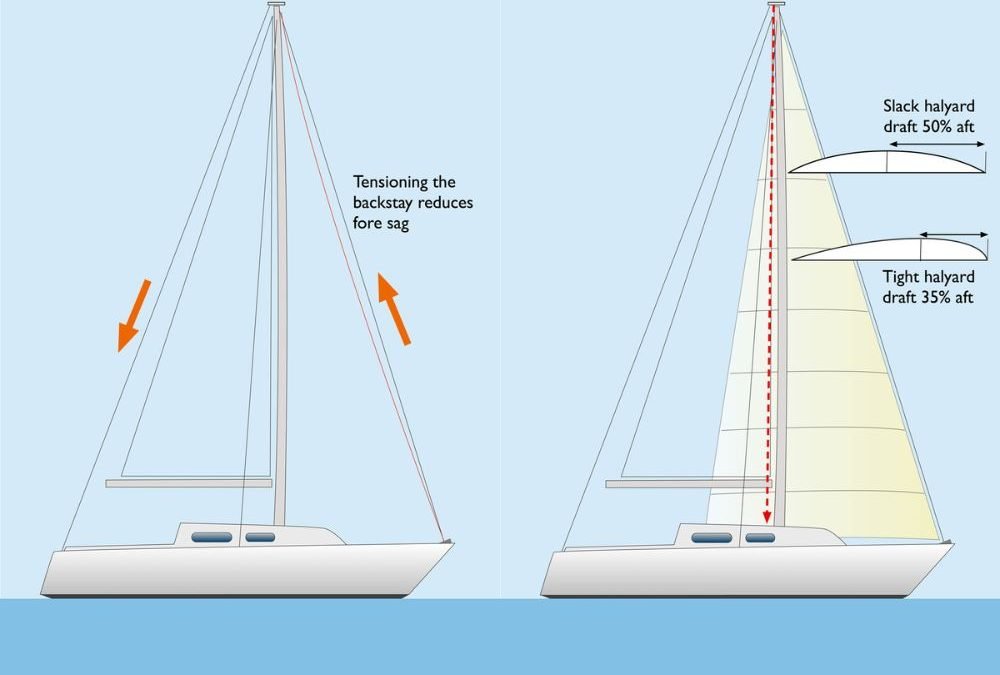I recently had two new sails made by Sanders Sails, based in Lymington UK. The first to arrive was the new genoa and it took me a little while to get to know it and learn how to adjust it correctly. Here is an aide memoire for getting to know how to trim a genoa so that it will deliver the best performance.
It is easier to get to know your sails in moderate conditions, ideally in winds up to Force 4.
Step 1. Getting started
Sailing upwind in 10-14 knots of breeze, sheet the sail in until the leech is just off the shrouds. Look up to make sure the sail is not hard up against the spreaders. In lighter airs, ease the sheet a little further.

Sheet lead position determines the relative position of the leech and the foot. Here there is even tension in the foot and the leech. The sail is well set and will create maximum drive.

The sheet lead position is forward, allowing the foot to sag, which makes the sail fuller. This is ok in light airs but when the breeze increases less power will be needed.

The car is moved well back, pulling the foot tight. The leech is open and there is twist in the top of the sail, de-powering the sail.
Step 2. Check the telltales
Telltales tell you whether the wind is flowing smoothly across the luff. The aim is to have all of them, on both sides of the sail, streaming together – but it is not always easy and takes practice. Here are a few tips to help you practice:
Your first check is to luff gently from a close-hauled course while watching the windward telltales.

If the top telltale lifts first this means the leech is too slack and the sail has too much twist. Moving the car forward along the track.
- If the top telltale starts lifting first, the sail has too much twist, meaning the leech is too slack because the sheet lead is too far aft. Move the car forward a little along the track.
- If the bottom telltale starts lifting first, the sail has too little twist. Move the car aft a notch or two.
- When they all lift together, you have got it right. After that, you only need to watch the bottom one while sailing. It is a good idea to mark the track with an indelible pen in order to remember the optimum settings in light, medium and high wind strengths.
Other telltale signs:
- If the leeward telltales are lifting, you either need to ease the sheet or sail closer to the wind.
- If the windward ones are lifting, you should sheet in or bear away.
- In strong winds when you are beginning to get over-powered, you will probably need the windward tales lifting slightly all the time.
- Once you have freed away from a close-hauled course, the top of the sail will tend to twist open so the telltales will no longer stream.
Step 3. Adjust the fullness
In light to moderate winds – especially in a chop – you need a relatively full sail for power. That means minimal backstay tension to induce some forestay sag and not too much halyard or sheet tension either. If you find you are not moving, try letting everything off a little.

Tightening the backstay increases forestay tension, which reduces the fullness of the sail. So, increasing forestay tension helps to improve speed and pointing ability in strong winds.
When the breeze picks up, you need less power or you will be sailing on your ear with terrible weather helm. The problem is that the extra wind pressure increases forestay sag and makes the sail fuller. So, to flatten it, tighten the backstay, increase the halyard tension and sheet in harder. You may also need to move the car back a hole to flatten the foot and de-power the top of the sail.
Step 4. Adjust the draft position
Draft position plays a major part in determining pointing ability and ease of sailing. Moving it forward (increasing halyard tension) means you won’t point so high, but reduces the heeling force in fresh conditions. The boat will also be more forgiving to sail, especially in a chop. So, if you just can’t get those telltales to settle no matter how hard you concentrate, make the sail a little rounder in the luff by tensioning the halyard.










